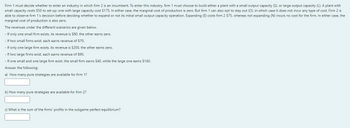
FINANCIAL ACCOUNTING
10th Edition
ISBN: 9781259964947
Author: Libby
Publisher: MCG
expand_more
expand_more
format_list_bulleted
Question

Transcribed Image Text:Firm 1 must decide whether to enter an industry in which firm 2 is an incumbent. To enter this industry, firm 1 must choose to build either a plant with a small output capacity (S), or large output capacity (L). A plant with
small capacity costs $50 to set up; one with large capacity cost $175. In either case, the marginal cost of production is zero. But firm 1 can also opt to stay out (O), in which case it does not incur any type of cost. Firm 2 is
able to observe firm 1's decision before deciding whether to expand or not its initial small output capacity operation. Expanding (E) costs firm 2 $75, whereas not expanding (N) incurs no cost for the firm. In either case, the
marginal cost of production is also zero.
The revenues under the different scenarios are given below.
- If only one small firm exists, its revenue is $80, the other earns zero.
- If two small firms exist, each earns revenue of $70.
- If only one large firm exists, its revenue is $200, the other earns zero.
- If two large firms exist, each earns revenue of $90.
- If one small and one large firm exist, the small firm earns $40, while the large one earns $160.
Answer the following:
a) How many pure strategies are available for firm 1?
b) How many pure strategies are available for firm 2?
c) What is the sum of the firms' profits in the subgame perfect equilibrium?
Expert Solution
This question has been solved!
Explore an expertly crafted, step-by-step solution for a thorough understanding of key concepts.
Step by stepSolved in 3 steps

Knowledge Booster
Similar questions
- Which of the following factors are considered when analyzing an indistry? I-the nature and conditions of governmental regulations II-the number, size and power of suppliers to the industry III- the development of new technologies relevant to the industry IV- the extent of competition within the industry A- I, II,III AND IV B-I, II AND III C-II, III, AND IV ONLY D-I, II, AND IV ONLYarrow_forwardWhat are the steps that would be needed for a company to transition from GAAP to IFRS?arrow_forwardWhat is the objective of the firm? Why? (Explain)arrow_forward
- eek 2a) What is a social contract and how does it relate to organisational legitimacy? b) Explain two ways organisations can use corporate disclosure policy to maintain or regainorganisational legitimacy?arrow_forwardShould a company allow the owners to use the resources as they see fit?arrow_forwardWhich business vehicle(Company or partnership) you will adopt if you are to set up a business and give reasons to support your choice.arrow_forward
- Briefly discuss how differentiated products in a monopolistic competitive framework can arise.arrow_forwardQuestion 2 Which of these is not one of the key concepts to consider when evaluating potential new clients and re-evaluating existing clients? Ethics and integrity. Company logo. Business activities. People involved.arrow_forwardexplain in detail, what is a firm, why firms exist and what are Coasian transaction c osts?arrow_forward
arrow_back_ios
arrow_forward_ios
Recommended textbooks for you

 AccountingAccountingISBN:9781337272094Author:WARREN, Carl S., Reeve, James M., Duchac, Jonathan E.Publisher:Cengage Learning,
AccountingAccountingISBN:9781337272094Author:WARREN, Carl S., Reeve, James M., Duchac, Jonathan E.Publisher:Cengage Learning, Accounting Information SystemsAccountingISBN:9781337619202Author:Hall, James A.Publisher:Cengage Learning,
Accounting Information SystemsAccountingISBN:9781337619202Author:Hall, James A.Publisher:Cengage Learning, Horngren's Cost Accounting: A Managerial Emphasis...AccountingISBN:9780134475585Author:Srikant M. Datar, Madhav V. RajanPublisher:PEARSON
Horngren's Cost Accounting: A Managerial Emphasis...AccountingISBN:9780134475585Author:Srikant M. Datar, Madhav V. RajanPublisher:PEARSON Intermediate AccountingAccountingISBN:9781259722660Author:J. David Spiceland, Mark W. Nelson, Wayne M ThomasPublisher:McGraw-Hill Education
Intermediate AccountingAccountingISBN:9781259722660Author:J. David Spiceland, Mark W. Nelson, Wayne M ThomasPublisher:McGraw-Hill Education Financial and Managerial AccountingAccountingISBN:9781259726705Author:John J Wild, Ken W. Shaw, Barbara Chiappetta Fundamental Accounting PrinciplesPublisher:McGraw-Hill Education
Financial and Managerial AccountingAccountingISBN:9781259726705Author:John J Wild, Ken W. Shaw, Barbara Chiappetta Fundamental Accounting PrinciplesPublisher:McGraw-Hill Education


Accounting
Accounting
ISBN:9781337272094
Author:WARREN, Carl S., Reeve, James M., Duchac, Jonathan E.
Publisher:Cengage Learning,

Accounting Information Systems
Accounting
ISBN:9781337619202
Author:Hall, James A.
Publisher:Cengage Learning,

Horngren's Cost Accounting: A Managerial Emphasis...
Accounting
ISBN:9780134475585
Author:Srikant M. Datar, Madhav V. Rajan
Publisher:PEARSON

Intermediate Accounting
Accounting
ISBN:9781259722660
Author:J. David Spiceland, Mark W. Nelson, Wayne M Thomas
Publisher:McGraw-Hill Education

Financial and Managerial Accounting
Accounting
ISBN:9781259726705
Author:John J Wild, Ken W. Shaw, Barbara Chiappetta Fundamental Accounting Principles
Publisher:McGraw-Hill Education